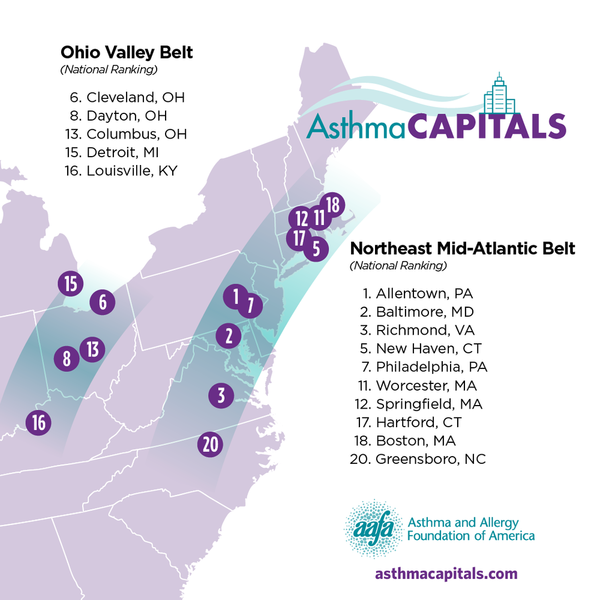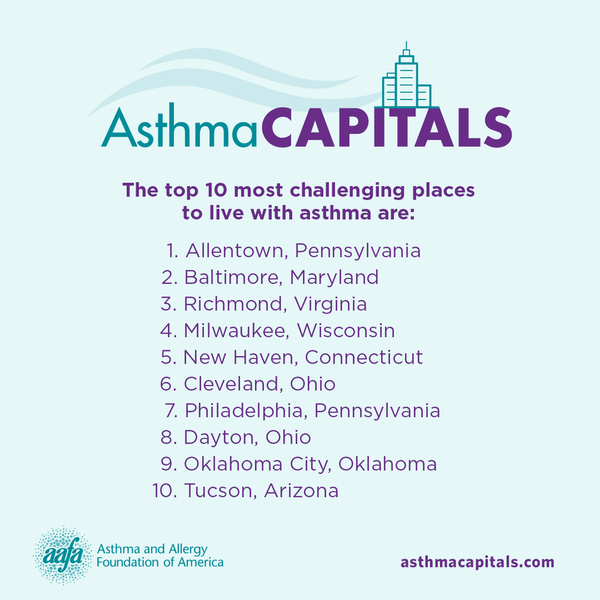AAFA Highlights the Most Challenging Places in the U.S. to Live With Asthma
On May 5, 2021, World Asthma Day, the Asthma and Allergy Foundation of America (AAFA) released the 2021 Asthma Capitals™ report. This report analyzes data from the 100 largest cities in the U.S. to identify the most challenging places to live with asthma. This year, Allentown, Pennsylvania, takes the top spot.
How Are Cities Ranked?
Knowing what puts someone at higher risk for asthma is an important part of understanding and treating the disease. Factors that impact asthma outcomes can vary from one city to another. The Asthma Capitals report ranks each city based on these factors:
- Asthma prevalence (or occurrence)
- Asthma-related emergency room visits
- Asthma-related deaths
The top 10 most challenging cities overall to live in with asthma in 2021 are:
- Allentown, Pennsylvania
- Baltimore, Maryland
- Richmond, Virginia
- Milwaukee, Wisconsin
- New Haven, Connecticut
- Cleveland, Ohio
- Philadelphia, Pennsylvania
- Dayton, Ohio
- Oklahoma City, Oklahoma
- Tucson, Arizona
The report also highlights risk factors that can influence asthma outcomes:
- Poverty
- Lack of health insurance
- Air pollution
- Pollen counts
- Long-term controller medicine use
- Quick-relief medicine use
- Smoking laws
- Access to asthma specialists
This year’s Asthma Capitals report acknowledges three major crises that unfolded in 2020. These events highlighted the burden of asthma across the United States:
- The COVID-19 pandemic that sparked a public health emergency and economic recession
- A climate crisis that caused major health impacts due to extreme weather patterns, exposure to record-breaking wildfire smoke, and other natural disasters
- Widespread upheaval over racial injustices that once again unmasked long-standing racial disparities in health
The 2021 Asthma Capitals report confirms regional trends previously identified by AAFA. Two “Asthma Belts” – the Ohio Valley area and the Northeast Mid-Atlantic region – continue to face a high burden of asthma. This is likely due to more industrial and urban populations. Asthma rates tend to be higher, especially among children, in urban locations due to more rental housing, more manufacturing and industrial businesses, and proximity to high-traffic roadways.
Additionally, two western cities climbed into the top 20 Asthma Capitals for 2021: Tucson, Arizona, and Fresno, California. There has been an increase in wildfires and air pollution in the west. In 2020, both cities had high rates of asthma-related deaths, and Fresno had high rates of asthma-related emergency room visits. High pollen levels and poor air quality contributed to these outcomes.

Take Action to Reduce Asthma Rates, Deaths, and Disparities
Some factors that impact asthma may seem to be beyond our control. But we can improve outcomes in our communities if we work together. The Asthma Capitals report identifies small steps that law makers, local and federal officials, health care providers, and people with asthma and their caregivers can take to help improve asthma in the community.
Advocate for Policies That Protect People With Asthma
Your vote matters. You can support asthma-friendly policies in local, state, and national elections. When watching local elections, look for proposals or policies on topics such as emissions, public smoking, clean air, traffic, and manufacturing. Laws on these topics can impact asthma rates and outcomes.
Talk to local leaders about asthma in their communities and ask them to consider supporting policies that benefit people with asthma.
Make Climate-Friendly Choices
If we all take small steps to reduce our personal contribution to air pollution, we can make a big difference. The COVID-19 pandemic showed us how reducing car and air travel results in cleaner air. Here are some changes you can make:
- Walk, bike, or skateboard
- Use public transportation or carpools
- Use cleaner energy
- Reduce food waste
- Eat less meat and switch to a more plant-based diet
- Use LED lights and turn them off when not in use
- Control heating and cooling with a smart thermostat
- Reduce, reuse, recycle
Learn About Managing Asthma
Taking asthma medicine is not enough to manage asthma. You also need to limit exposure to your asthma triggers. Work with an asthma specialist to come up with the best plan for you. AAFA offers free resources to help:
- Online support community
- ASTHMA Care for Adults online course
- List of CERTIFIED asthma & allergy friendly® products to help you make your indoor air healthier
- Opportunities to participate in research to improve future asthma treatment
If you don’t have asthma, you may know someone else who does. Remember to share the resources above with others.
Support AAFA’s Mission
Your gift can help us continue to support families and advocate on behalf of communities impacted by asthma.
The 2021 Asthma Capitals™ report is an independent research project of the Asthma and Allergy Foundation of America in part by support from the Pharmaceutical Care Management Association (PCMA) Foundation.
How Can I Learn More About the Report?
AAFA publishes the Asthma Capitals™ report to raise awareness about the nationwide impacts of asthma. The report analyzes data from across the continental United States and ranks the 100 largest cities by how challenging they are to live with asthma.
Visit aafa.org/asthma-capitals to see the full list and to learn more about asthma management and risk factors.
Join our online community where you can get support for asthma and allergies and stay up to date on news and research.




Comments (5)